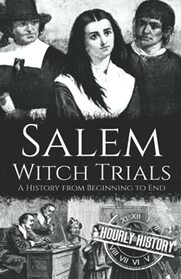Since the Salem Witch trials are a fairly known set of court cases and executions, it is wonderful that Hourly History decided to add something different. This is a deep dive into how and why conditions formed the perfect storm that they were for the Puritans' Witch Trials. This is fascinating reading because some of the causes are not so obvious.
It is important to understand that the Puritan worldview dictated their lives. Their goal was to create God's ideal community and that God had specifically appointed them to do just that. If they failed, it was their fault and God would visit his wrath on them. They expected God's Second Coming and it was their duty to purify the earth in preparation for his coming. They also believed that God already knew who would be saved and those who wouldn't.
The wrinkle here was: Puritans were compelled to prove to their society that they were part of the blessed and not the damned. If they were excommunicated, where could they go? They did not celebrate ANYTHING. Their children were to be prepared for the grim life by disciplining them against their natural inclinations towards joy. Because other denominations were joining the Puritans, their rules were becoming more strict. Puritans did not hold with religious tolerance; they ostracized others of different Christian beliefs. The Puritans had an insular society; they became almost pathological in their fear of dissent and opposition.
This book makes a point of saying that Puritanism was declining in numbers by 1662. Historians agree that Puritanism was over by the 1740s. The first three women who were accused of being witches were outliers (not part of the Puritan fold). There is an interesting discussion of what was going on with the young girls who claimed others of witchcraft. There were social tensions as well as gender tensions. Men believed that women were weaker and more likely to be tempted by the devil.
It was a surprise to learn that witch-hunting was not a new problem. Witch hunts date back to ancient times and continued through 1750 in European societies. The New World settlers were familiar with witch hunts in England between 1644 and 1646 (in which one hundred people died). Another point this book makes is that the witch worries began in the middle of a particularly brutal winter in New England.
The rest of the book is about the actual claims, the trials, executions, etc. Then, the book talks about the legacy of the Witch Trials in literature and theater. These aspects of the trials are more well-known. I thought the strength of this book was their analysis of the culture of the Puritans and how it helped spawn the Witch Trials.
It is important to understand that the Puritan worldview dictated their lives. Their goal was to create God's ideal community and that God had specifically appointed them to do just that. If they failed, it was their fault and God would visit his wrath on them. They expected God's Second Coming and it was their duty to purify the earth in preparation for his coming. They also believed that God already knew who would be saved and those who wouldn't.
The wrinkle here was: Puritans were compelled to prove to their society that they were part of the blessed and not the damned. If they were excommunicated, where could they go? They did not celebrate ANYTHING. Their children were to be prepared for the grim life by disciplining them against their natural inclinations towards joy. Because other denominations were joining the Puritans, their rules were becoming more strict. Puritans did not hold with religious tolerance; they ostracized others of different Christian beliefs. The Puritans had an insular society; they became almost pathological in their fear of dissent and opposition.
This book makes a point of saying that Puritanism was declining in numbers by 1662. Historians agree that Puritanism was over by the 1740s. The first three women who were accused of being witches were outliers (not part of the Puritan fold). There is an interesting discussion of what was going on with the young girls who claimed others of witchcraft. There were social tensions as well as gender tensions. Men believed that women were weaker and more likely to be tempted by the devil.
It was a surprise to learn that witch-hunting was not a new problem. Witch hunts date back to ancient times and continued through 1750 in European societies. The New World settlers were familiar with witch hunts in England between 1644 and 1646 (in which one hundred people died). Another point this book makes is that the witch worries began in the middle of a particularly brutal winter in New England.
The rest of the book is about the actual claims, the trials, executions, etc. Then, the book talks about the legacy of the Witch Trials in literature and theater. These aspects of the trials are more well-known. I thought the strength of this book was their analysis of the culture of the Puritans and how it helped spawn the Witch Trials.




